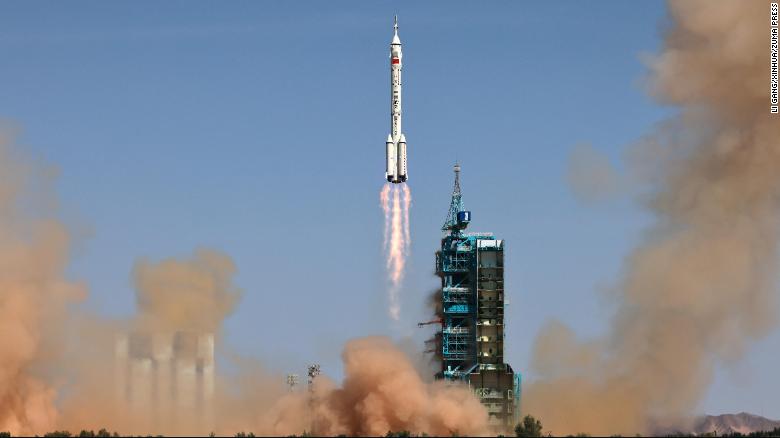
The crewed spaceship Shenzhou-14, atop a Long March-2F carrier rocket, is launched from the Jiuquan Satellite Launch Center in northwest China, on June 5.
(CNN)China successfully launched another manned mission to its new space station on Sunday, sending three astronauts who will continue construction work for six months, China’s Manned Space Agency (CMSA) announced.
The astronauts lifted off on the Shenzhou-14 spacecraft at 10:44 a.m. local time, launched by a Long March 2F rocket from the Jiuquan Satellite Launch Center in the Gobi Desert, Inner Mongolia.
The team will live and work at the Tiangong Space Station’s Tianhe core module for six months before returning to Earth in December. Tiangong means Heavenly Palace.
The crew includes Chen Dong, Liu Yang and Cai Xuzhe, who are expected to dock with the space station about 6.5 hours after launch.
Chen, the mission commander, was aboard China’s Shenzhou-11 manned space mission in 2016 and previously held the record for longest stay in space by a Chinese astronaut. Liu became the first ever Chinese woman in space in 2012 on the Shenzhou-9 mission. And this will be Cai’s first mission in space.
This is the third crewed mission during the construction of the space station, which China plans to have fully crewed and operational by December 2022. The first crewed mission, a three-month stay by three other astronauts, was completed in September 2021. The second, Shenzhou-13, saw three astronauts spend six months in space for the first time.
Enter your email to sign up for CNN’s “Meanwhile in China” Newsletter.
close dialog
The team aboard Shenzhou-14 will help with the docking, setting up and testing of the two laboratory modules Wentian and Mengtian, which are set to launch in July and October.
The modules will be assembled into a T-shaped structure, along with the Tianhe core cabin — the main living space for the astronauts — which will be expanded from 50 cubic meters to 110 cubic meters, the CMSA said. The astronauts will also conduct two to three spacewalks.
At the end of the Shenzhou-14 mission, another three astronauts are expected to rotate and live with the crew for five to 10 days, bringing the number of Chinese astronauts in space at the same time to a record six.
Once construction is completed, the Tiangong space station is expected to last for 15 years. China plans to launch two crewed missions and two cargo missions to the station every year, according to the CMSA.
China’s space program
The Shenzhou-13 mission last year was a major step for the country’s young space program, which is rapidly becoming one of the world’s most advanced.
China’s space program was late to the game, only established in the early 1970s, years after American astronaut Neil Armstrong had already landed on the moon. But the chaos of China’s Cultural Revolution stopped the nation’s space effort in its tracks — and progress was postponed until the early 1990s.
Space administrators picked two classes of astronauts in 1998 and 2010, laying the path for a rapid acceleration in space missions. Aided by the economic reforms of the 1980s, China’s space program quietly progressed until the launch of the first crewed mission in 2003.
 Pride News Daily NEWS
Pride News Daily NEWS








